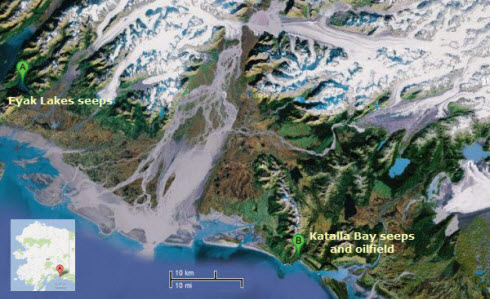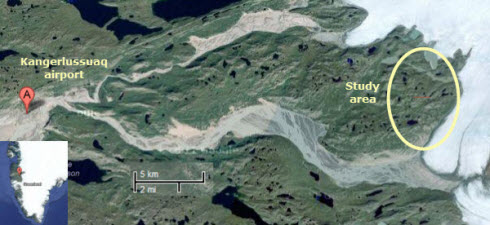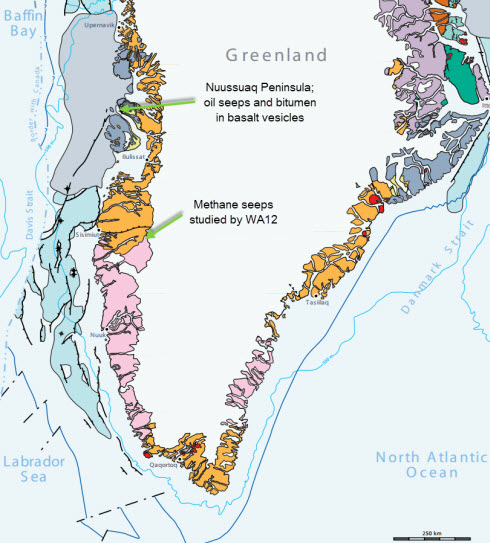Subcap Methane Feedbacks. Part 3: Methane from beneath the ice
Posted on 21 December 2012 by Andy Skuce
The previous two parts (one here and two here) of this series examined the evidence for seeps of geological methane through the cap provided by permafrost and looked at estimates of the magnitude of such seeps in relation to other sources of atmospheric methane. In this section, we will look at the emerging evidence for actual and potential methane releases related to glaciers and ice sheets. The sources of this methane are varied: fossil methane released through reactivated fractures; organic matter once buried and now exhumed; and possible methane hydrates lurking under the big ice sheets.
The Southern Alaska subcap seeps
There is a cluster of subcap seeps in southern Alaska in areas where there is only sporadic permafrost. This is an area that was covered with a major ice sheet during the last ice age. Today, it is a region where nearby modern glaciers are rapidly receding. These seeps are underlain by a sedimentary basin that contains coal beds and an active petroleum system. Katey Walter Anthony and her colleagues (WA12) showed that major seeps in this part of Alaska are within 10km of the nearest glacier and close to large, previously mapped faults. Seeps of gas and oil are common above active petroleum systems and are often used in hydrocarbon exploration for highlighting attractive areas to explore.

Figure 1. Map and satellite image showing the location of the Eyak Lake and Katalla Bay seeps in South Central Alaska. Source: Google Maps.
This kind of subcap seep results from the sudden unweighting of the crust caused by rapidly retreating mountain glaciers. The consequent flexing produces changes in the local stress state, activating small movements on deep faults and opening fractures that may allow methane to escape to the surface.
WA12 did not attempt to quantify this effect, either for Alaska or for the Arctic in general. In my opinion, while it is a plausible contributory mechanism for the particular seeps they observed in Southern Alaska, there are probably not that many other areas in the Arctic where rapidly retreating glaciers are within a few kilometers of actively methane-seeping sedimentary basins. For example, as shown in a map of the sedimentary basins of Greenland in Figure 2, the western and south-eastern flanks of the Greenland ice sheet are underlain by Precambrian rocks that are unlikely to contain methane. There are some hydrocarbon-generating sedimentary basins, including an oil seep, on the western tip of the Nuussuaq Peninsula in West Greenland, but this is approximately 100 km west of the edge of the Greenland ice sheet, too far away to be influenced by elastic deformation of the crust due to retreating ice.
Figure 2. Modified from a sedimentary basins map made by the Geological Survey of Greenland. The pink and orange colours indicate PreCambrian rocks. Blue and light grey areas offshore are the extents of sedimentary basins more than 3km thick, which may have active petroleum systems. The ice sheet is mostly >100km from the edge of sedimentary basins, too far away for retreating ice to have any effect on gas seepage from the basins. For the full map and legend, click on this link.
The main importance of the glacial-unloading mechanism may lie in the permanent effect that the repeated advances and retreats of northern hemisphere ice sheets have had as they passed over high-latitude sedimentary basins like steamrollers, flexing and fracturing the rocks below them, and facilitating future seepage. Previously glaciated areas may therefore be regions where gas-seepage rates, in the absence of a cryosphere cap, would tend to be higher than in comparable never-glaciated sedimentary basins at lower latitudes.
The Greenland subcap seeps

Figure 3. Satellite image of the location of the studied seeps in West Greenland in relation to the western edge of the Greenland ice sheet. Source: Google Maps.
Some lakes in western Greenland, located ~20 km east of Kangerlussuaq airport and within a kilometre of two of the edge of the ice sheet, were found to have very rapidly bubbling methane seeps. Analysis of this gas shows that it is derived from microbial decomposition of relatively young (about 1500 year-old) organic matter. The organic matter was probably capped by Little Ice Age and older advances of the ice sheet and was exposed by retreat of the ice in the past 100 years. The methane in the seeps is not therefore old, geologic methane as in the other types of subcap seep. No attempt was made by WA12 to quantify the pan-Arctic potential of seeps of this nature.
The Greenland ice sheet is not the only case where retreating ice has revealed buried organic matter: Lonnie Thompson reported finding a small amount of >50,000 year-old plant matter beneath the retreating Quelccaya ice cap in Peru.
Sub-cap methane hydrates?
Some recent work suggests that significant quantities of methane may have been trapped under continental ice sheets, perhaps in the form of methane hydrate. For example, Weitemeyer and Buffett (2006) proposed that the release of sub-ice-sheet methane hydrate from under retreating North American ice sheet may have been responsible for a portion of the observed increase in atmospheric methane during past glacial cycles. It is unclear to what extent similar processes may have occurred under the now-vanished Fenno-Scandinavian ice sheet.
In today's interglacial period, there are two ice sheets remaining, in Greenland and Antarctica. Emerging research is pointing to the possibility that significant amounts of methane could be trapped under these masses of ice.
Wadham et al (2010) estimated that huge quantities of methane may be currently stored as hydrate under the Antarctic ice sheet. They claimed that these volumes of hydrate are comparable in volume to the quantity of methane hydrates in Arctic permafrost and that modest ice-sheet retreat rates of 700-2000 km2 per year would be sufficient to cause out-gassing of methane at rates large enough to affect atmospheric methane concentrations. More recently, Wadham and her colleagues have published a paper (press release, paywalled article) with more details on the potential store of sub-ice-sheet gas hydrates in Antarctica. They state:
We conclude that the Antarctic Ice Sheet could constitute a previously neglected component of the global methane hydrate inventory, although significant uncertainty exists. The predicted shallow depth of these reserves also makes them more susceptible to climate forcing than some other global hydrate reserves. If substantial methane hydrate and gas were present beneath the WAIS [West Antarctic Ice Sheet], hydrate destabilization during episodes of ice-sheet collapse could act as a positive feedback on global climate change during past and future ice-sheet wastage. Further validation of these assertions awaits deep drilling into ASBs [Antarctic Sedimentary Basins] via future international initiatives.
Clearly, this is another area where the latest research is revealing that there may be new sources of carbon-cycle feedback lurking in the ground under the disintegrating cryosphere. Researchers are starting to understand the potential and the timing of these feedbacks better, but uncertainties abound and most scientists are naturally reticent when it comes to predicting how and when methane releases from these locations may occur. In the next and final part of this series, I'll offer my personal perspective on this.































 Arguments
Arguments
























 0
0  0
0






Comments